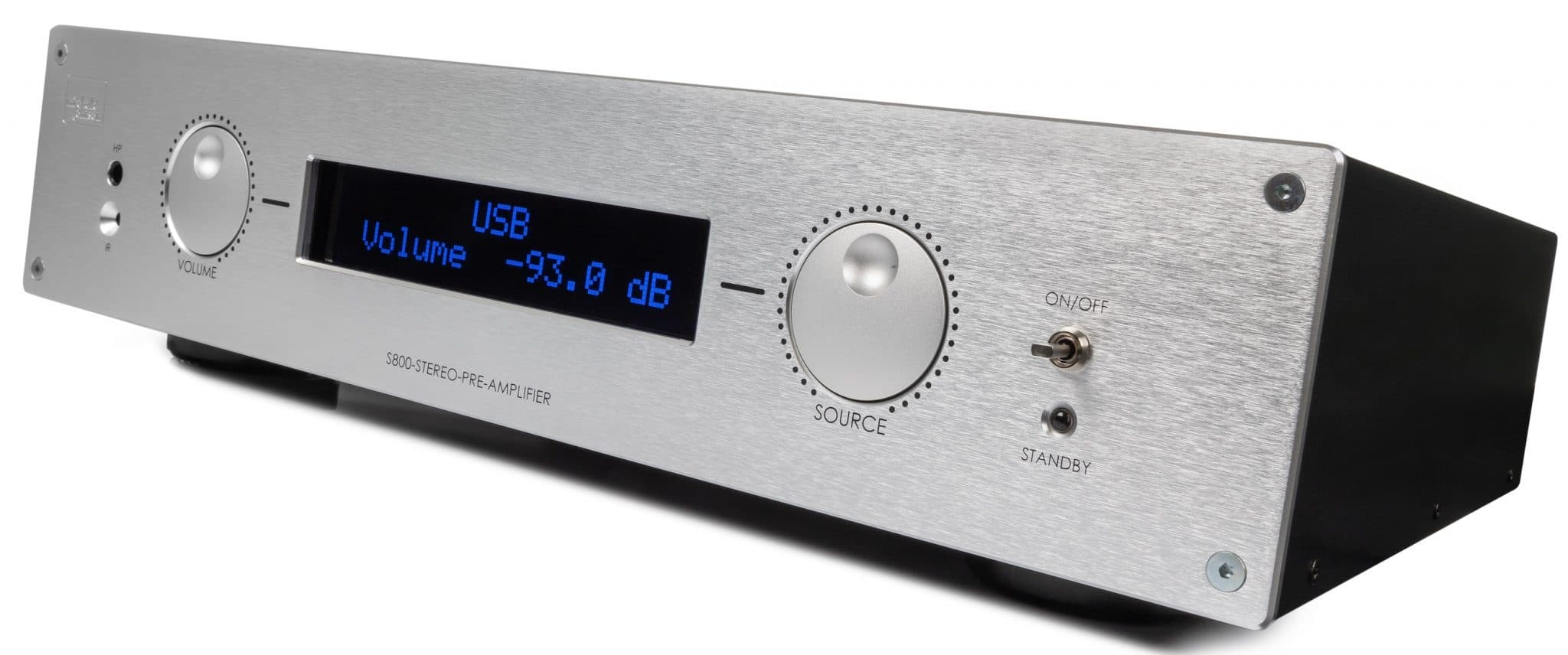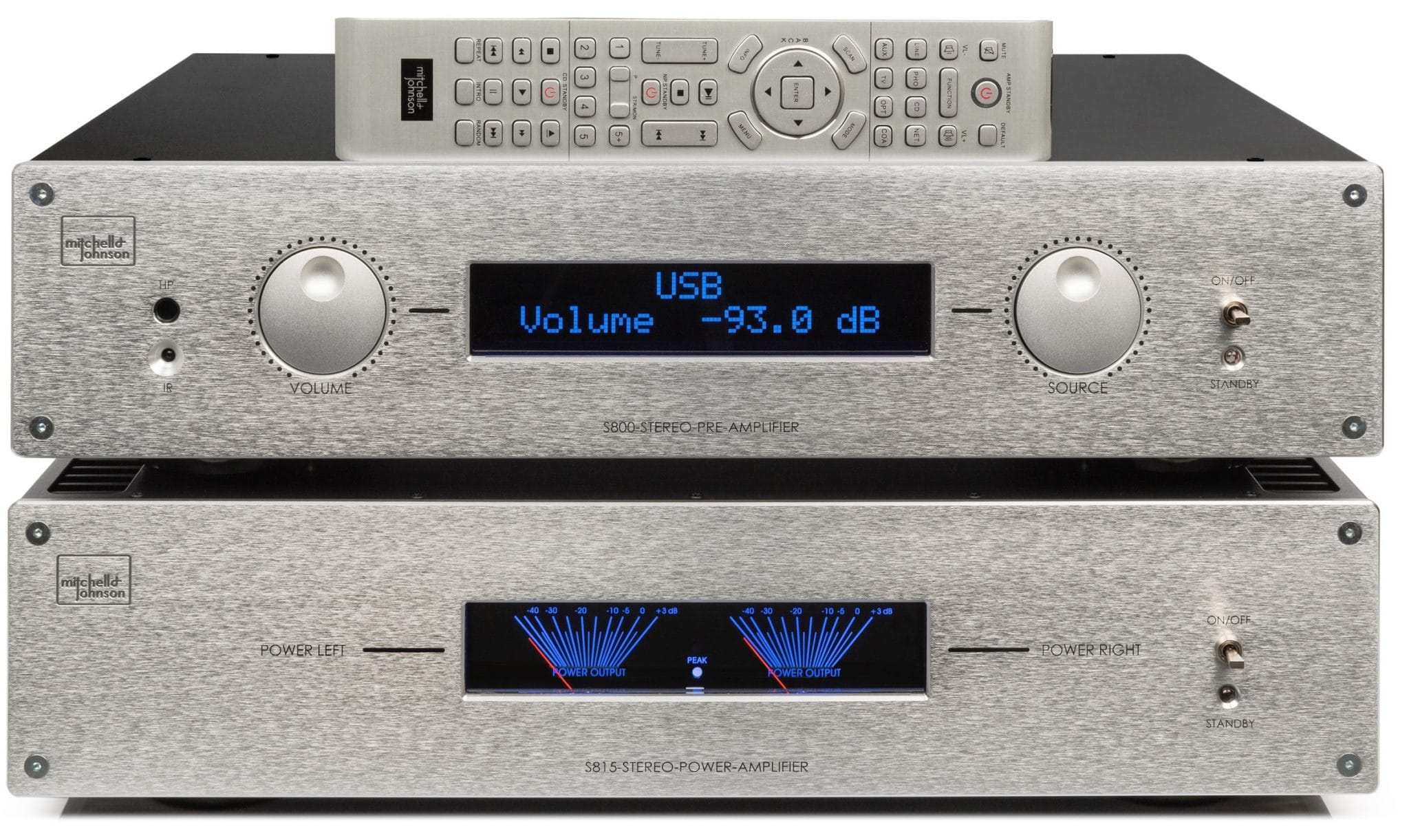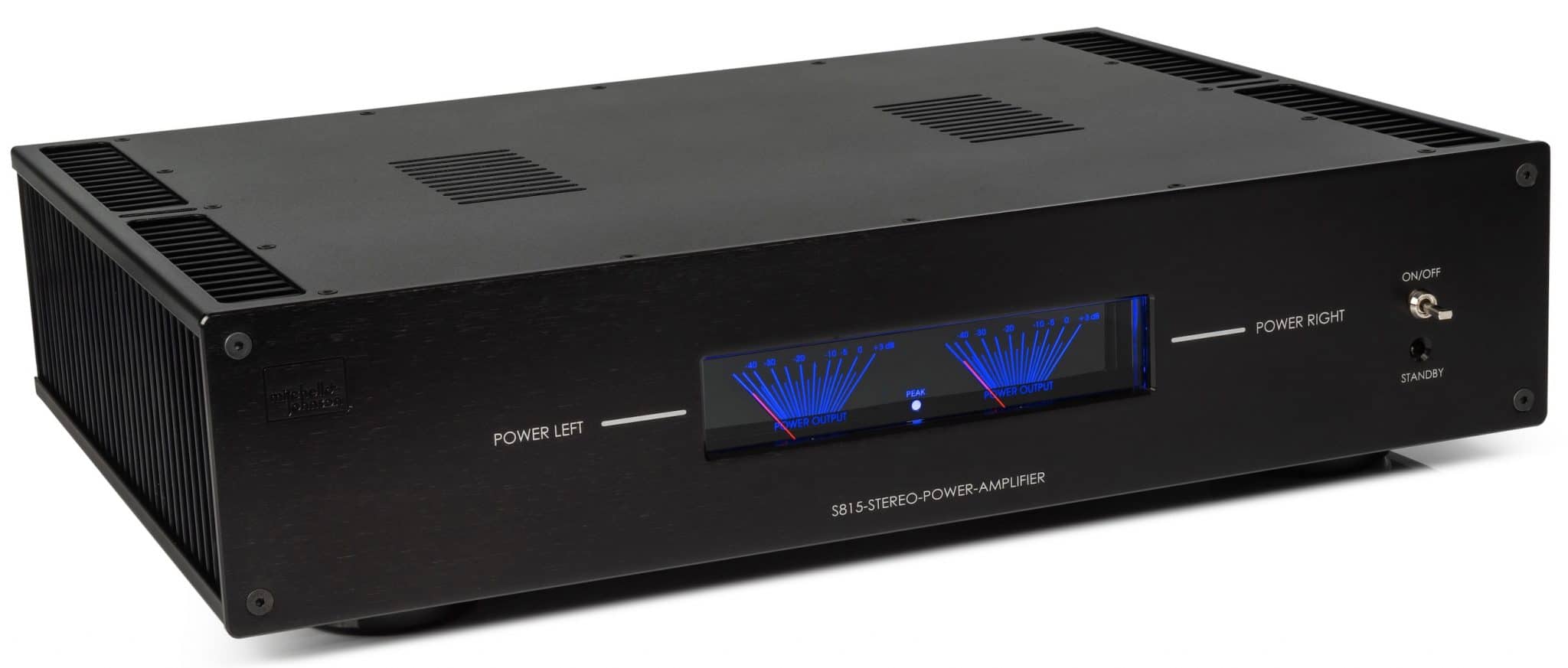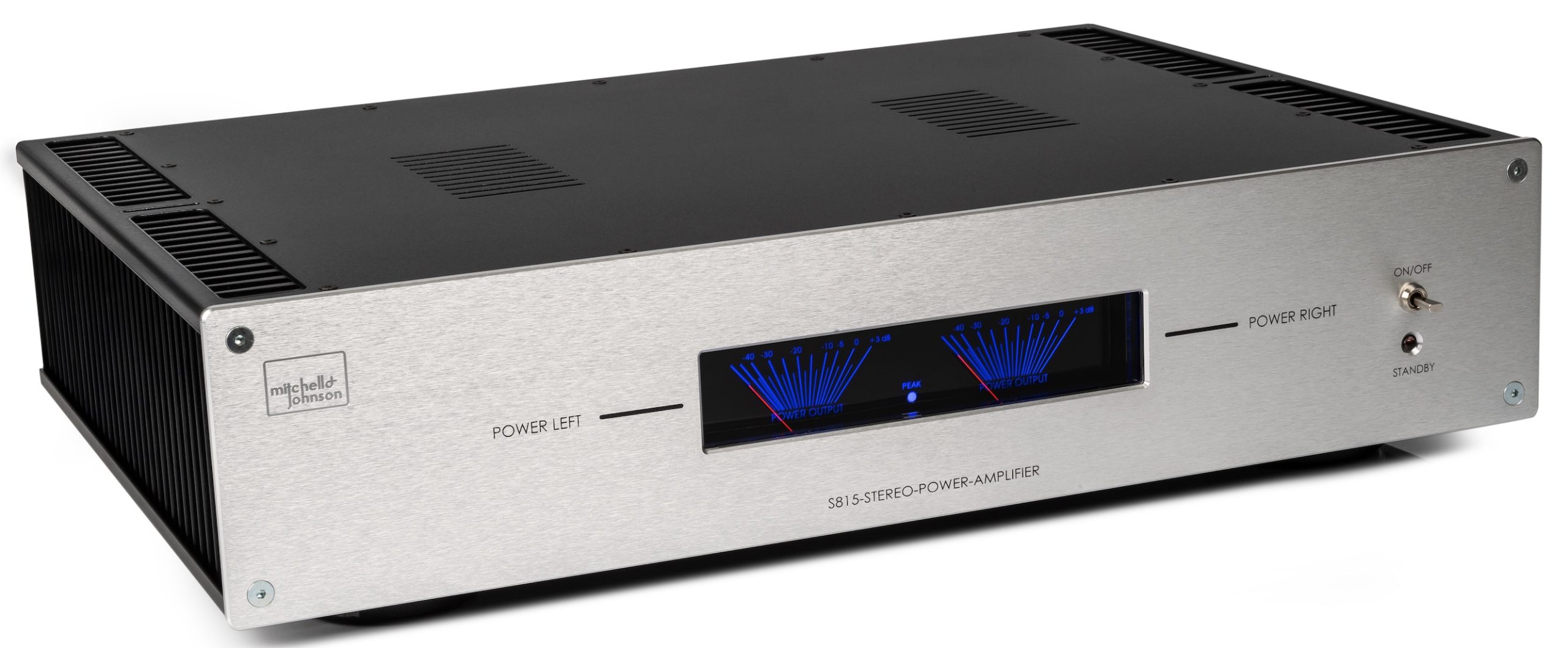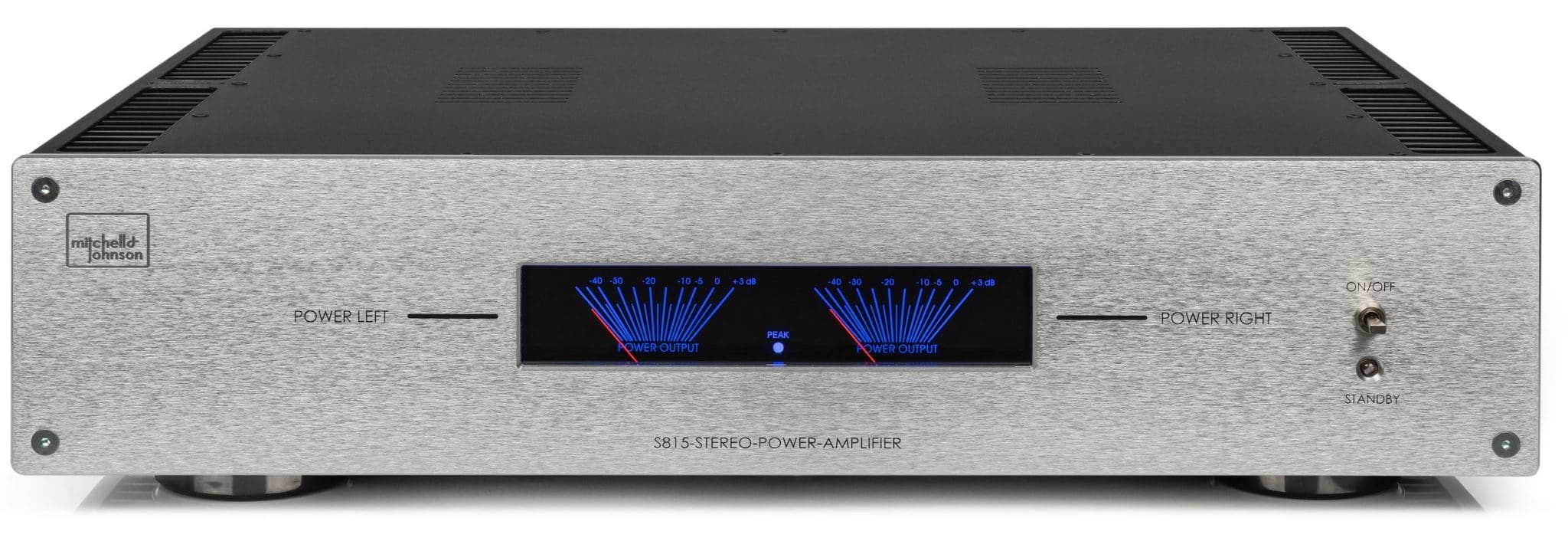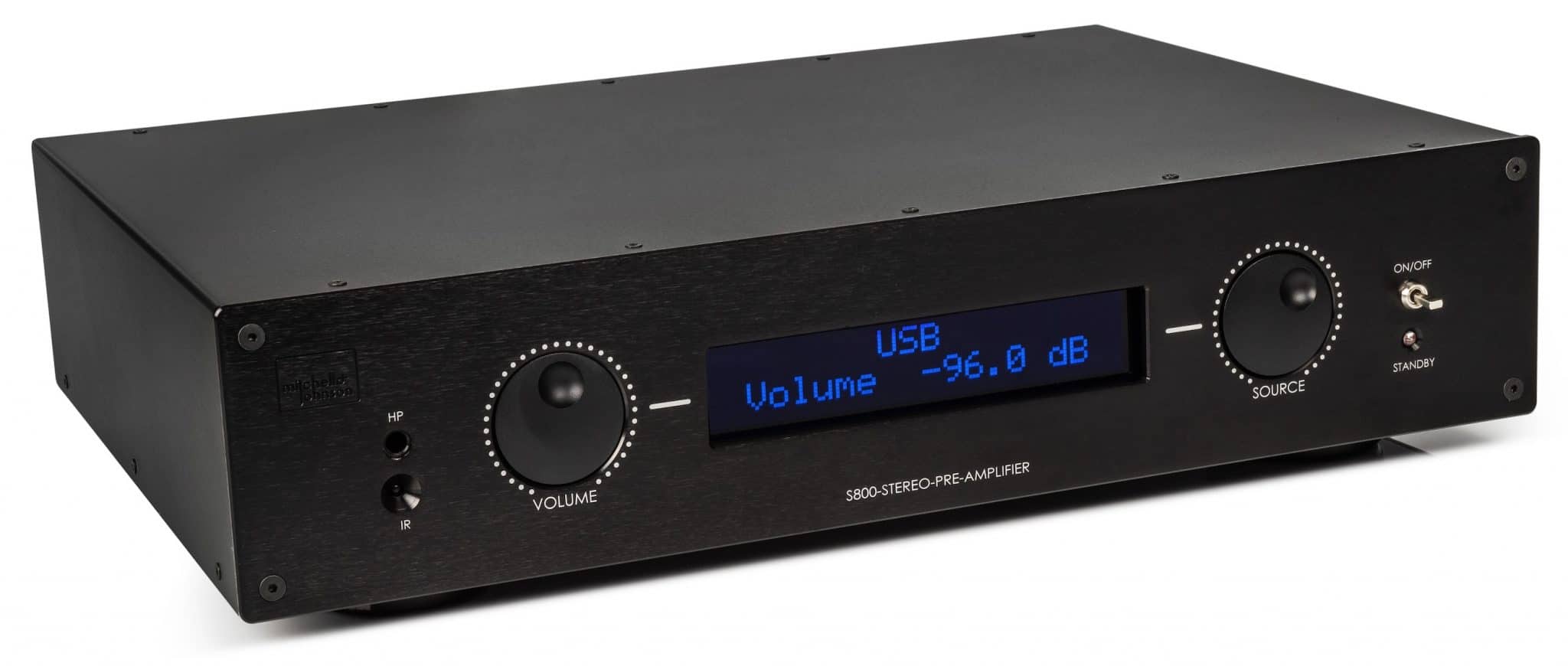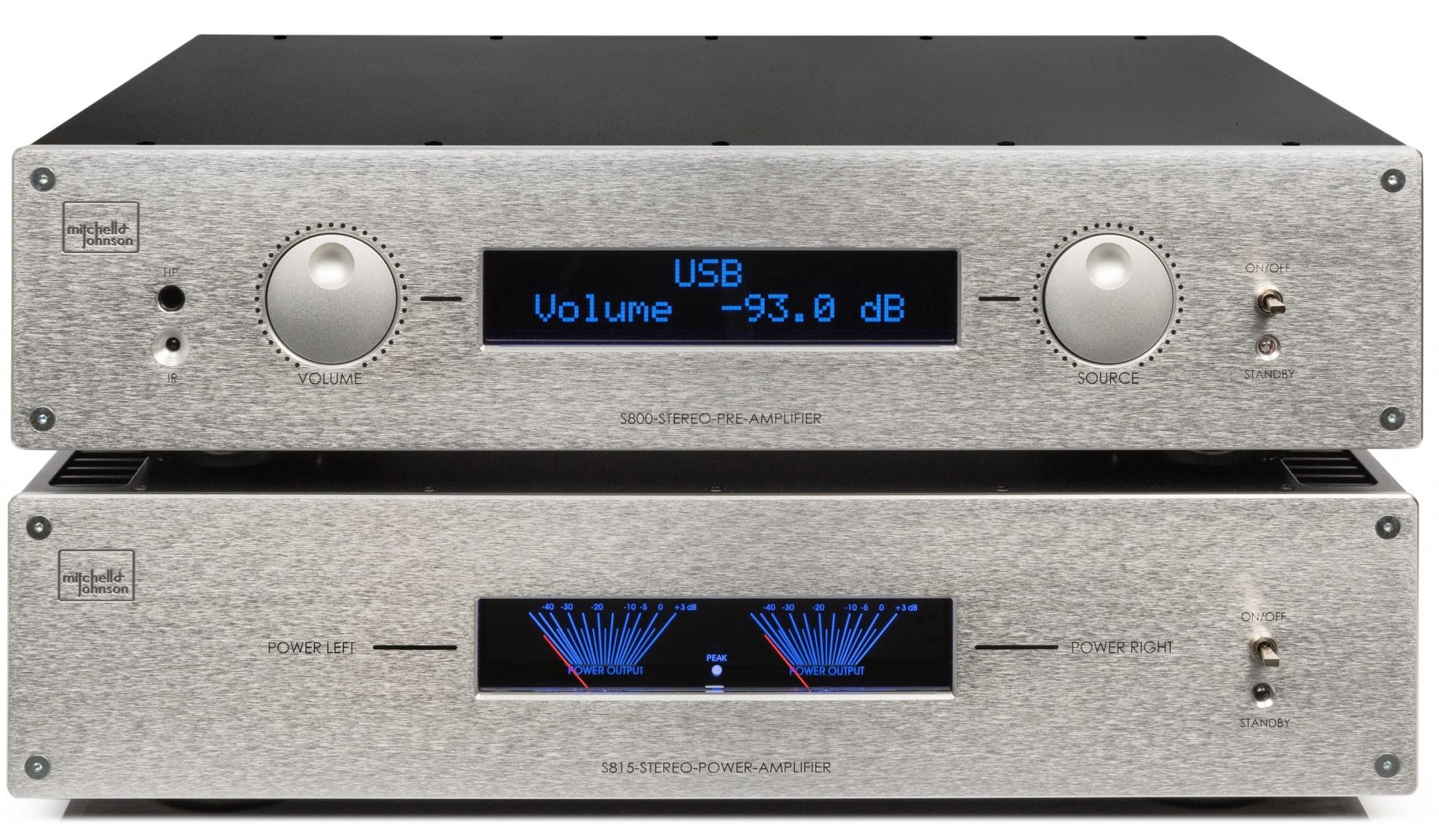The Article
S800 & S815 Pre & Power Amps: Mitchell & Johnson
18th December 2018
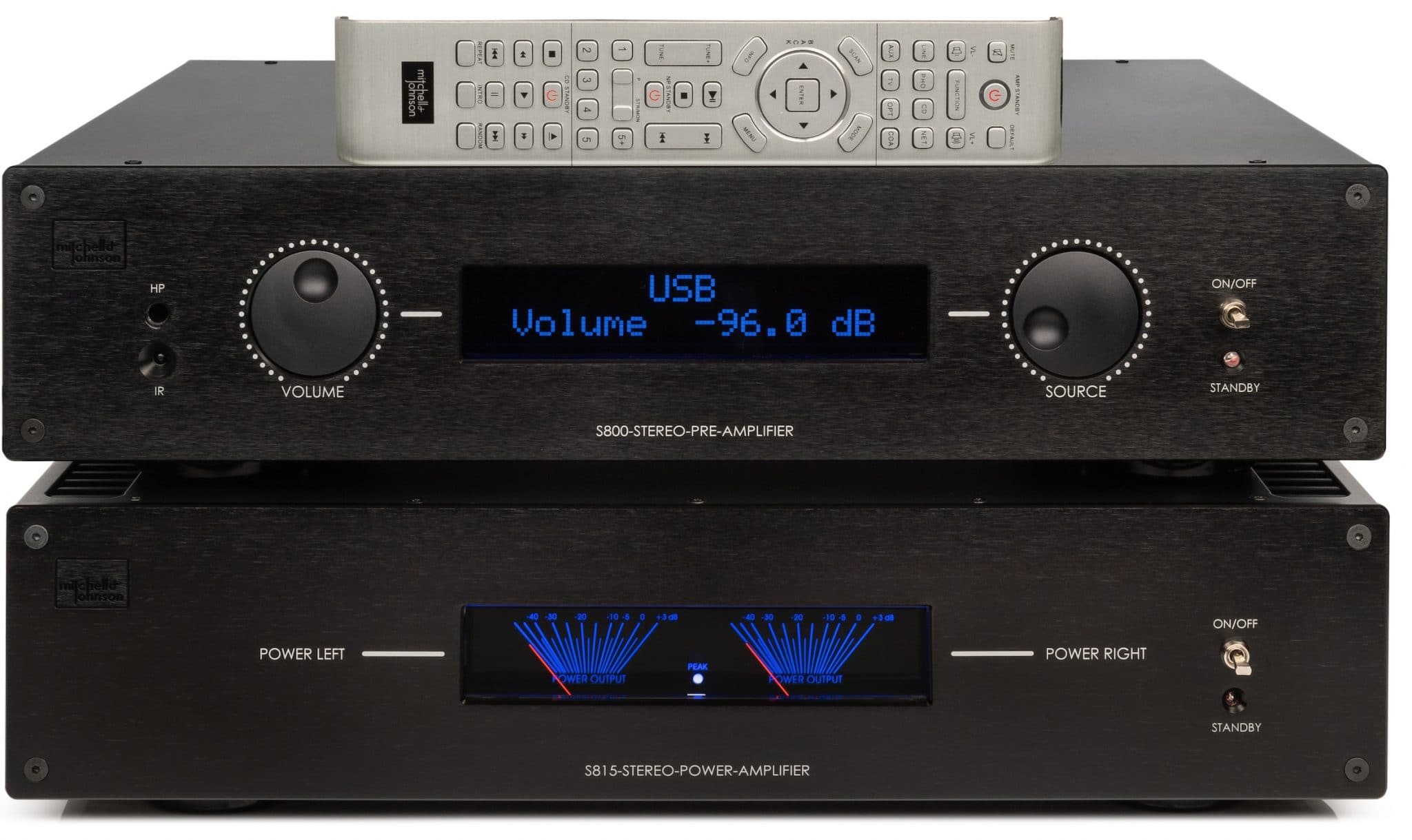
Is it possible to have soul mates in hi-fi? We’re talking hi-fi components here. Paul Rigby wonders if Mitchell & Johnson’s S800 Stereo Pre-Amplifier and S815 Stereo Power Amplifier are nothing but star-crossed lovers
This is a bit of an odd review, as you’ll see. I tested the S800 pre-amplifier as a separate product, then the S815 power amplifier and only then did I bring them both together as a pair to see how they complimented each other. Three products, in effect? Indeed and three different results too. Hold on to your hats!
THE PRE-AMP
Let’s look at the S800 pre-amp firstly. The design of the pre-amp raises questions and not particular happy ones at that. In fact, I recommend that the designer of the interface be shot at dawn, without a blindfold. The front fascia features a very nice bold toggle switch on the right that is spring-loaded upwards for power off and downwards to initiate power. Slightly quirky but cute. So far, so good. The far left sits a 6.35mm headphone socket and IR sensor. The centre is a large LED read-out. All remains fine to this point.
The issues begin with the two rotary selectors positioned either side of the read-out. Both are flush with the fascia with a finger indent. I much prefer a proper knob in these circumstances to prevent finger slippage but, hey ho, the irritation is only minor.
The major problem is the imprecision of these selectors.
Let’s start with the volume knob (left) which progresses with definite clicks as the rotary knob is moved. I noticed that each decibel of gain is divided into half decibel clicks. Hence ‘one click = half a decibel’. Slow but acceptable (kinda). Trouble is that progressing one click often has zero affect on gain. You read right, sometimes I can move the controller by a click and…nothing happens. In fact, sometimes two, three, four, five and six clicks might also have no affect on gain. Imagine that for a second. You move a volume knob by six clicks and absolutely zero happens. Nada. Zilch.
What’s worse is the lack of consistency. Gain might actually be changed after one click, then again it might only be changed after three. Oh the frustration! My worst case scenario saw eight clicks to move the gain half a decibel. Eight!
Now, I can see Mitchell & Johnson waving at me from the back row here and shaking its head at me. What it wants you to do is to get in there and spin this wheel of fortune like a banshee and not notice the wooly imprecision of the thing. And, in practice, that’s what I recommend that you do. Be damned with precision. Just get in there and whisk the dial around like a good’un until you get the correct volume. Doing it this way works fine and then you can effectively ignore the above. That is, if you gauge volume by listening to it and not looking out for the numbered readout, then you’ll be fine.
For a pair of amps costing over £2.5k though? That is not good enough, I’m afraid.
The Source selector on the S800 uses the same breed of knob. Which scared the life out of me after my volume experiences. Basically, the source on this pre-amp is selected via a volume-type knob with as many clicks featured within. Why would any designer sanction that breed of control for a source?
I really have to take time out here and ask with a slightly shrill voice now and repeat…why!? This selector is just as dodgy. Sometimes it works, sometimes it doesn’t.
When it works correctly, the source changes on the second click. Why that is deemed acceptable is beyond me. It is not. Sometimes, though, the second click results in no change of source at all. On one occasion, I had to rotate the selector eight clicks to move from SP/DIF 1 to SP/DIF 2! Sometimes they worked fine throughout, then I’d have to rotate three, four or more times to find the source of choice.
More than that, there’s no physical label indicator as to what source is what and where. Hence, you cannot jump to your preferred source immediately. You have to laboriously run through a vertical list every…single…time, becoming ever more dizzy as the infernal rotary detector goes around and around…
On the good side, if you push the volume selector inwards, the sound is muted. If you push the volume selector for two to three seconds you can access a host of options such as renaming inputs, changing the phono amplifier from MM to MC and more.
The rear of the S800 chassis is excellently featured, though, with two Pre outs plus a Tape out and Sub out. Balanced outputs are there too. The power socket is centred while a DAC section, bottom left, offers USB, three opticals and three coaxials. There’s connections to link this box with other M&J boxes, balanced inputs plus four pairs of single-ended RCA inputs and a built-in phono amplifier handling MM and MC.
Which are nice options to have but look, hey, never fear about that troublesome interface, eh? The remote will sort out the other issues, yes?
Ah, yes, the remote.
THE REMOTE
The remote looks impressive, in a Sony/Denon/Yahama/Pioneer kinda way. A slim chassis packed with buttons. Designed, so it seems, for full system use with other connected components such as a CD player and the like.
The volume works fine here, half a decibel via a single button press. The eight source selectors also work, in a fashion. Hence, you press Line to bring up the RCA input and then you keep pressing Line to cycle through the four RCA inputs. Aux and TV do nothing. Net triggers the USB source on the S800 which is slightly odd. Pressing CD triggers the Balanced inputs – not sure why that is. The other issue is that you need to press the buttons hard. It’s easy to believe that you’ve pressed a button whereupon nothing happens.
The rest of the buttons shouldn’t alter anything on the S800 but they do, slightly. Accidentally pressing many of the other buttons changes the volume by half a decibel. But pressing it again does nothing. More oddness.
The interface is a pain in the backside. It really is. That said, once you get going, once you use it for a while, the issues lessen a tiny bit. You accommodate and mentally ‘make do’. Hence, everything works…in a fashion. I reckon you could forgive it, if the boxes sounded completely brilliant. We’ll see.
THE POWER AMP
The S815 power amplifier is a much simpler affair. The star of the show are the VU meters. I have to admit, I’m a sucker for VU meters. I talked to the company about them and they exclaimed that sourcing VU meters, any VU meters, is proving to be ever more difficult. As an available accessory for manufacturers, they are rapidly becoming rare beasts. I see that as a crying shame.
The front fascia arrives with a similar toggle power switch on the front and enough inputs and outputs, on the rear, to handle standard stereo speakers or bi-amping. The power socket is centrally mounted again. My main impression with the power amplifier is its weight! For the chassis size, at 16kg, it is deceptively heavy. This is a 150W in 8 Ohms beast of an amp offering Class A/B. It’s a high current design using six Toshiba audio grade output transistors per channel.
SOUND QUALITY
I started with the S800 pre-amp connected to my solid state, Valvet Class A mono blocks and played an original cut of Richie Havens’ Something Else Again on Verve and the track, From the Prison. Sound was of a very high output which meant that it was crisp and even cool in output with very lively mids that verged on the strident. The S800 tended to push the upper mids to the limit and sometimes over.
Because of this, Havens’ vocal was honed and precise. Sometimes too precise. His delivery was accurate and on the nail in terms of what he was saying and how those words were timed. His acoustic guitar strums were also highly focused with detail dug from the depths of the song and presented to the ear for easy access. In fact, detail had no-where to hide on this track, even shy and subtle aspects of the music were lifted to be examined because of the light shined upon the midrange.
Turning to The Police and Ghost in the Machine on CD and playing Too Much Information, the clinical nature of the midband was accentuated by this rather hot master. In this way, the S800 accentuated what was already there, adding a bright touch to the midrange. This effect was heard on the brass accompaniment especially.
In other areas, the bass provided a tight and punchy output with a brisk and rhythmic jab. The focused aspect of the bass enabled the song to move swiftly and at pace, preventing any accusations of drag. Overall the soundstage was broad, expansive and showed good discipline in terms of preventing bloom or smearing across all frequencies.
I then changed the power amp to my Ovation and found that it slightly softened the sound to produce a progressively more even and balanced sound output with the attendant saxophones providing a contained presentation and vocals being richer in tone. The inherent precision of the S800 was still resident with vocals and percussion being spare and fast paced.
Swopping my reference external phono amplifier for the M&J built-in model, I was pleased with the output. Yes, the upper mids and treble were rolled off a tad and dynamic reach did not have me punching the air but, saying that, for a phono amplifier built into the chassis, it provided an admirable output with a relatively balanced and even sonic output with meaty bass and decent midrange performance. You can do a lot worse, put it that way.
The headphone stage was briefly tested and very nice it was too. Big on the lower end, bass response was meaty and massy in nature with a decent midrange rendition providing enough upper frequency detail to keep things interesting.
I then moved to the S815 power amp. In came the Music First Passive Pre to connect to the M&J power amplifier. I kept the CD from The Police running and was impressed at the open and airy nature of the power amplifier within the midrange. I was also surprised to hear how well the instrumental separation of the power amp allowed me to clearly hear the previously shy rhythm guitar which normally sat behind the mix somewhat. Part of the reason for this new detail was superb instrumental separation which allowed each instrument room to manoeuvre, giving even delicate details a chance to naturally rise to the surface without any forced encouragement. The result was a wholly natural and balanced presentation that flowed with impressive ease.
What I did notice, at this stage, with both my passive pre and, later, my Aesthetix valve-based pre was the energy required to run it. In fact, the Music First did struggle to establish a high volume during testing. Similarly, I had to push the gain 10 or more clicks higher than normal on my expensive valve pre-amp to achieve a high volume. The low sensitivity of the M&J power amplifier was an issue.
Nevertheless, for now, I was impressed with the overall balance of the sound and the 3D image from the soundstage which was part of an interesting sonic structure of the band. That is, the instruments were laid out logically and sensibly with enough air around each to allow fine detail to be easily detected. More than that, the expensive Aesthetix didn’t shame the M&J power amplifier at all, which shows the M&J inherent quality.
A similar story was to be told via Ritchie Havens on vinyl. The open and balanced output exhibited fine detail from guitar string pluck and strums with textured detail from the latter betraying the energy placed upon them by Havens. His vocal delivery, meanwhile was emotive and full of nuance which, because his is pretty much ‘out there’ on his own during this track, is both important and necessary for the track to provide a proper impact.
WE’LL STAY TOGETHER
So what happens when you put both of these boxes together? I did just that and connected up the M&J pre-amp and power amp.
I sat there and gaped. I just couldn’t quite believe it.
All of the struggling. All of the issues. All of the ‘ifs’ and ‘buts’, the pushing of round pegs into square holes and more… All gone. All of it. What was left? A supreme example of quite superb amplification. Like two siblings that hate being apart or to soul mate lovers who fret when distance is placed between them, the 800 Series amplifiers have – and I repeat that HAVE – to be used together as a pair. That much was sonically certain.
Gone was the stridency of the S800 pre-amp. Gone was the clinical side to the mids and gone was the rather plastic bass. For the S815 power amplifier? Gone was the huffing and puffing as it tried to get up off its backside to do some work.
What was left was a smooth flow to the midrange. For the Richie Havens track, his busy work on his acoustic guitar was an exhibition of pure talent and skill and the M&J amplifiers allowed you to hear that in its full glory. The emotion he rammed into his trademark explosive strumming was here in spades while the textured elements of his voice only added to the fine detail of the song.
On CD, The Police had never sounded as civilised during this test as they did here. Even with the pre connected to £7,000 power amps (I also briefly hooked the pre-amp to my Icon Audio valve mono blocks) and the power amp connected to a £6,000 pre amp, the sound never sounded as neutral, balanced and as insightful as when the two M&J boxes were linked together.
Vocals were intricate with elaborate harmonies providing an entertaining richness while the organic sounding bass was easily followed. The instrumental separation allowed delicate detail to be tracked with ease, Stuart Copeland’s complex technique can sometime bedazzle hi-fi equipment but there was enough space to allow him to play and folic and for the ear to pick up every smack, tap and splash. Saxophone backing was brassy without being forward and lead guitar even displayed it own reverb tail.
Finally, I added my Astell&Kern AK120 and Bob Marley’s Jamming at 24bit/96kHz via the pre-amp’s optical port and found a similar sonic response. Maybe a bit cooler in terms of the overall sonic presentation and slightly narrower in dynamics but these notes were relative to the source. On its own terms, the optical output produced a highly satisfying musical response with a beautifully weighty bass.
There is one moral to this story that you must bear in mind. If you buy this pair of amplifiers and you wish to upgrade later on, upgrade the M&J pairing immediately, DO NOT split them and think you can get away with a new pre or power amp and then look to upgrade the other box later on. It won’t work. Well, it will but the experience will not be anywhere near as pleasant. Either keep both M&J units or upgrade both together.
CONCLUSION
I did ring Mitchell & Johnson about the above review and it did confirm the sonic signature of the individual pre-amp and power amp products. It also confirmed my sound quality findings but it revealed to me that the pre-amp and the power amp where designed to be used together. They are voiced as a pair. In effect – and this is a novelty I’ve never heard of before – the S800 and 815 are or rather is an integrated amplifier in two separate boxes. The best of both worlds, you might say, for any integrated. That is, they offer components targeted to work together but the separate chassis configuration is highly effective in lowering noise. The results are quite, quite remarkable.
As such, because of the brilliant sonic output, I can even forgive the dodgy interface on the S800 pre-amp (I still want a contract out on the designer, though).
My review journey for these two boxes has been quite a roller coaster. Some hi-fi products are voiced to work with each other and that’s what the 800 Series pre and power units are. They are literally made for each other. Separated, they will work with other products in varying degrees of quality but they never really fly. Put the both together, though, and they fit perfectly, providing a superb duo that easily challenges other amplification solutions at a similar price point in terms of sound quality. As a pair, they provide balance, delicacy, detail, midrange insight and organic bass. A match made in heaven, indeed.
MITCHELL & JOHNSON 800 SERIES PRE-AMPLIFIER & POWER AMPLIFIER
Tel: 0845 643 5064
Website: mitchellandjohnson.com
MITCHELL & JOHNSON S800 STEREO PRE-AMPLIFIER
Price: 1,299
GOOD: connectivity, punchy bass, detail, precise midrange, works best with the M&J power amplifier
BAD: interface design, remote design, strident upper mids, high output
RATING: 6
MITCHELL & JOHNSON S 815 STEREO POWER AMPLIFIER
Price: 1,299
GOOD: low noise, instrumental separation, airy midrange, works best with the M&J pre-amplifier
BAD: high impedance, remote design, bass emphasis, low sensitivity
RATING: 7
MITCHELL & JOHNSON S800/S815 PRE & POWER AMPLIFIER AS A PAIR
Price: £2,598
GOOD: midrange insight, organic bass, spacious soundstage, balance output
BAD: interface design, remote design
RATING: 8
[Don’t forget to check out my Facebook Group, The Audiophile Man: Hi-Fi & Music here: www.facebook.com/groups/theaudiophileman for exclusive postings, exclusive editorial and more!]
REFERENCE
Goldring 1042 cartridge
Aesthetix Calypso pre-amp
Music First Classic passive pre
Ovation High Fidelity Model 1701 power amplifier
Valvet AR1 power amplifier monoblocks
Sennheiser HD650 headphones with Oyaide cabling
Tellurium Q Silver Diamond cables
Blue Horizon Professional Rack System
Harmonic Resolution Systems Noise Reduction Components
All vinyl was cleaned using an Audio Desk’s Ultrasonic Pro Vinyl Cleaner

